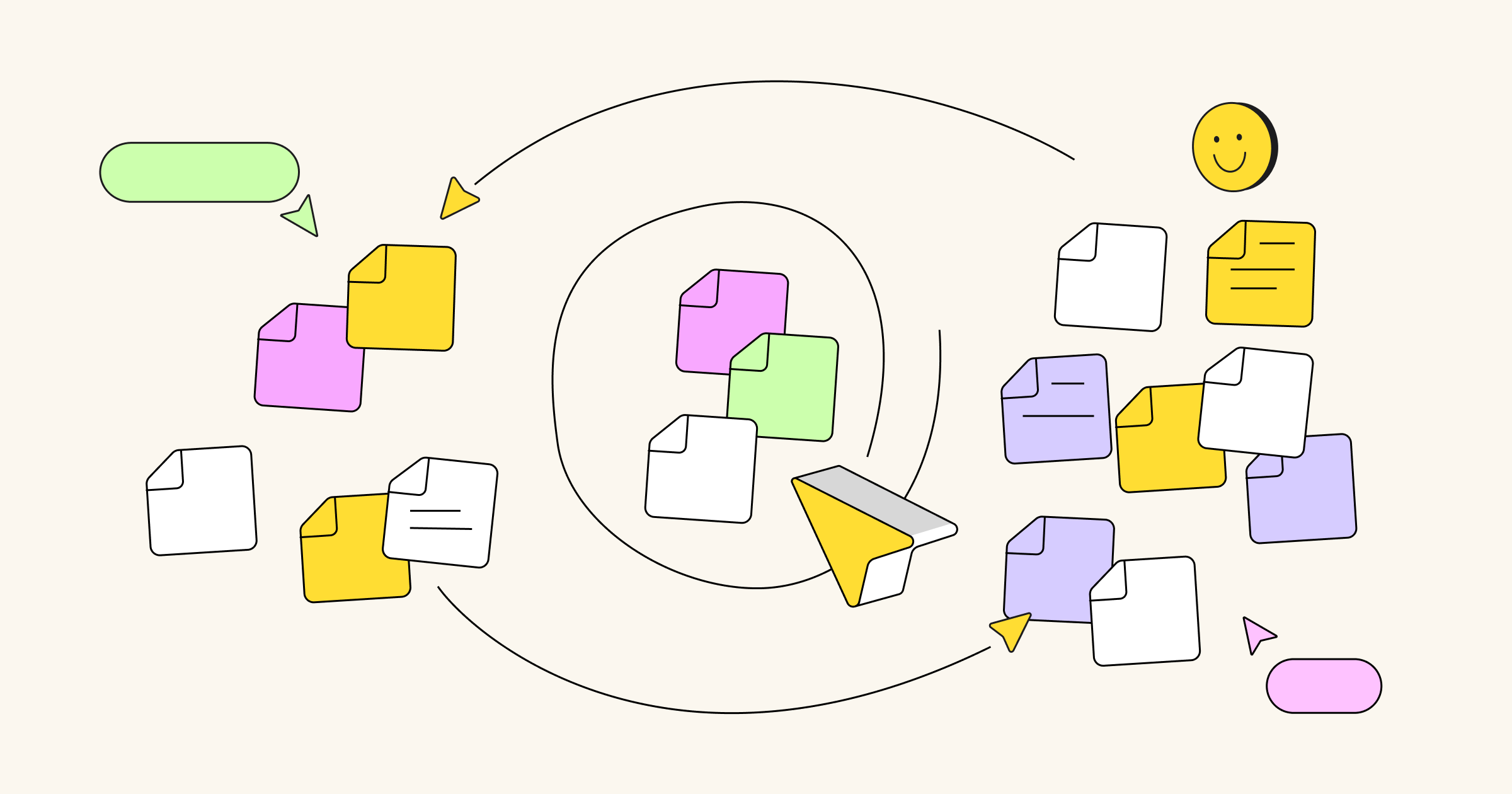Without an effective way to organize business processes, things can get forgotten or duplicated, or become overly complicated.
For entrepreneurs, staying organized may involve a simple to-do list or task management system. But, as businesses grow, processes become more complex as they cross departmental boundaries and authority owners.
Business process modeling allows companies to visualize these processes so that they can take steps to streamline them.
Let’s look at exactly what business process modeling is, what benefits it creates, and how using business process modeling notation (BPMN) diagrams can help you get clear on your business processes.
Try Miro’s BPMN Templates
What is business process modeling?
Business process modeling is a method of identifying, modeling, designing, and implementing business processes. Its scope is broader than task management and focuses on a complete end-to-end process.
You might be wondering what the purpose of business process modeling is compared to other forms of process management. Let’s look at the distinction.
Business process modeling focuses on the design of new processes. It differs from business process mapping, which is focused on optimizing current business processes.
Both business process modeling and business process mapping fall under the umbrella of business process management.
Business Process Modeling Notation (BPMN) has become the go-to way of visualizing business process workflows. It’s an intuitive tool, and stakeholders across the business should be able to understand it easily.
What is a BPMN diagram?
A BPMN diagram is a business process diagram that specifically uses the BPMN modeling language. Other modeling languages — such as the Unified Modeling Language (UML) — also use business process diagrams to depict processes visually.
Why use business process modeling?
There are several benefits to using business process modeling when creating new organizational workflows.
Business process modeling:
- Offers businesses a method to define and understand their organizational processes visually using business process diagrams. This can make it easier to identify functional boundaries and see how new processes connect with existing processes.
- Provides an industry-standard notation that should feel familiar to both internal and external stakeholders. It’s simple to learn yet powerful enough to capture complex processes fully. This means getting everyone on the same page should be quicker, as a lengthy onboarding process isn’t required.
- Bridges the communication gap that frequently occurs between business process design and implementation. It can be challenging to describe a business process in words effectively, and business process diagrams prevent things from getting lost in translation.
- Allows businesses to maintain a record of how a process is mapped out. This means, should the business environment change in the future, it’s easy to identify any potential impact on the process and make changes quickly to optimize it.
Pros and cons of using BPMN diagrams
Like most tools, using BPMN diagrams has both advantages and disadvantages. We’ve highlighted the key benefits of business process modeling above, and these feed into the two main advantages of using the diagrams. There are also a few disadvantages to walk through.
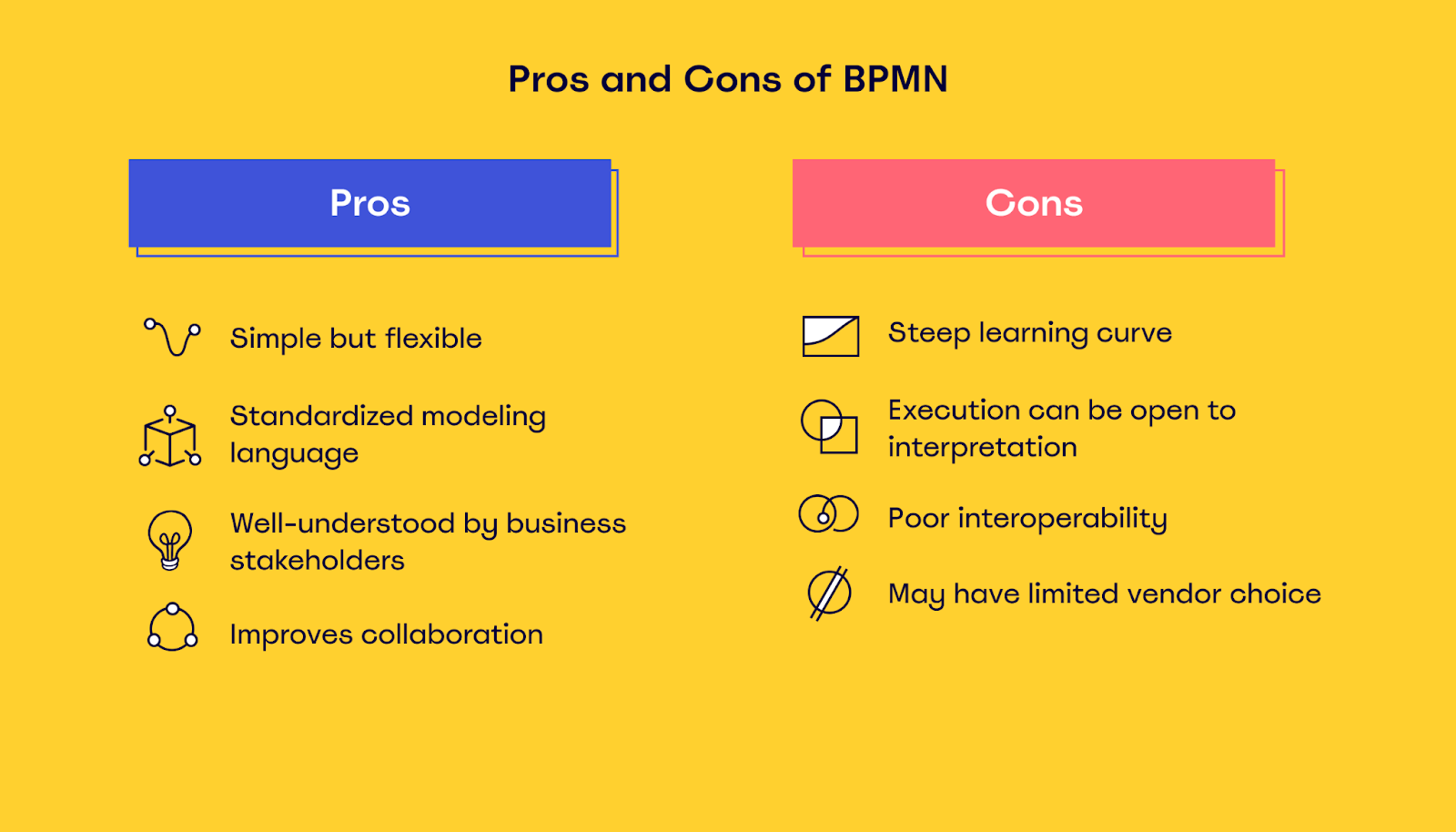
Pros of using BPMN diagrams:
- BPMN diagrams are a simple concept, but the BPMN modeling language allows for over 100 different graphical elements. The comprehensive amount of notations make the diagrams flexible, with the ability to map even the most complex business process.
- BPMN is standardized by the ISO (International Standards Organization), which means it’s transferable between businesses and industries. This makes it easy for BPMN diagrams to be well-understood by most stakeholders.
And, through having a common language, collaboration between teams becomes more straightforward and effective.
Cons of using BPMN diagrams:
- The comprehensive nature can initially make it difficult to grasp the BPMN modeling language fully. This means if you have team members new to BPMN diagrams, there can be quite a steep learning curve, which can cost you time.
- Despite the modeling language standards clearly defining how people should use the BPMN diagram elements, different BPMN vendors may implement the execution of these diagrams differently.
This can lead to poor interoperability between BPMN tools, and modelers may be restricted to certain vendors or products depending on how they interpret the execution of BPMN diagrams.
Core features of BPMN diagrams
Now you’re clear on the benefits that BPMN diagrams can bring to your business, it’s worth taking a look at the key features of BPMN diagrams and how to go about building one.
There are four main elements that make up a BPMN diagram:
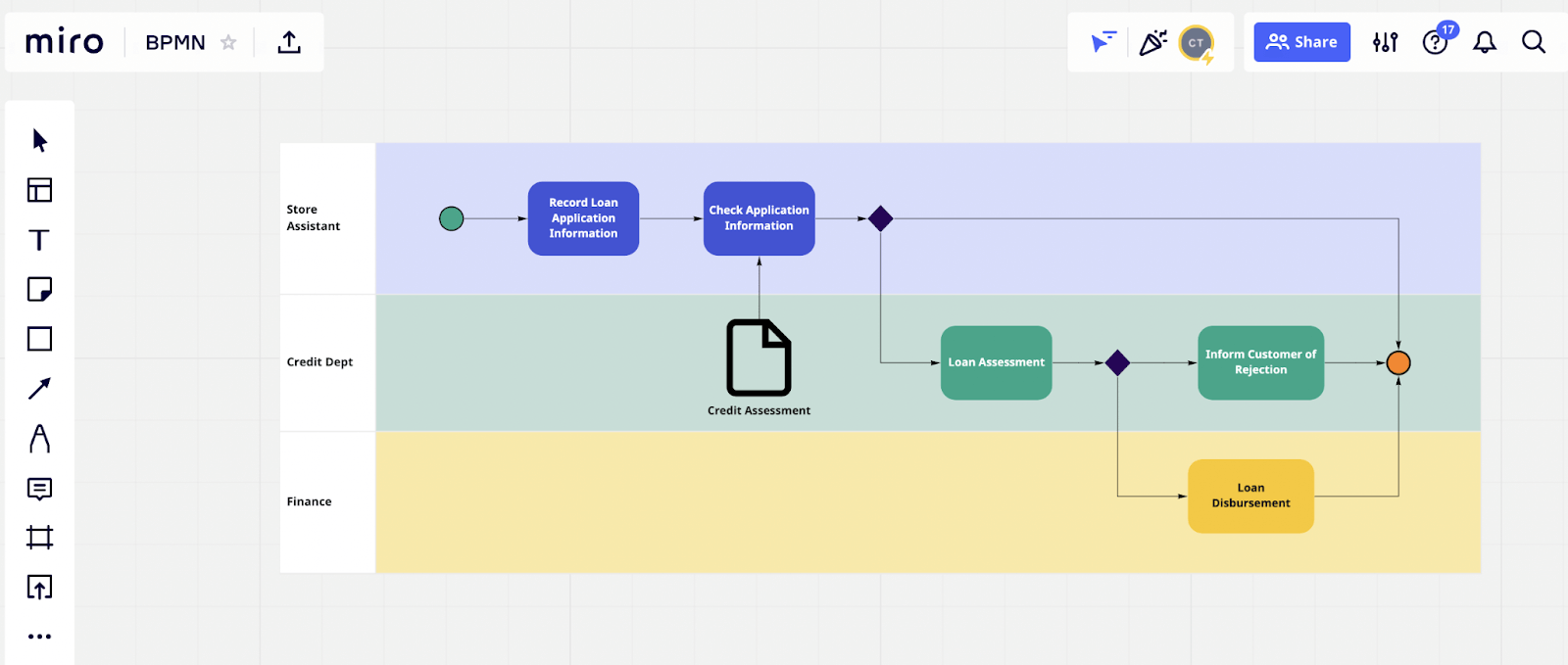
1. Pools and swim lanes
Pools are the largest component of a BPMN diagram. They represent the entirety of a business process from the perspective of one group of participants (e.g., a department or a single role, like an assistant manager).
Like an actual swimming pool, pools can be broken down into swimlanes, which can run vertically or horizontally across the diagram. These swimlanes represent specific groups or individuals that are completing tasks within the larger pool.
Every BPMN diagram must contain at least one pool and one swimlane.
Let’s use a business process mapping example to bring this to life. Consider you’re a store signing a customer up for a store credit card. Your pool contains the actions you take to complete that process, which might include:
- Recording the loan application information
- Checking the application information (via credit assessment)
- Completing a loan assessment
- Informing the customer of the outcome
- Making the loan available to the customer’s account

The store assistant has only two actions in their swimlane, which is to take loan application information from the customer, and to send that information off to be processed.
As there’s just one participant in this process, it’s a simple BPMN diagram example. However, the actions taken by the store assistant trigger other processes, which would be shown in subsequent swimlanes.
Indicated by the outgoing and incoming arrows, there are other departments that have a significant impact on the successful completion of this process.
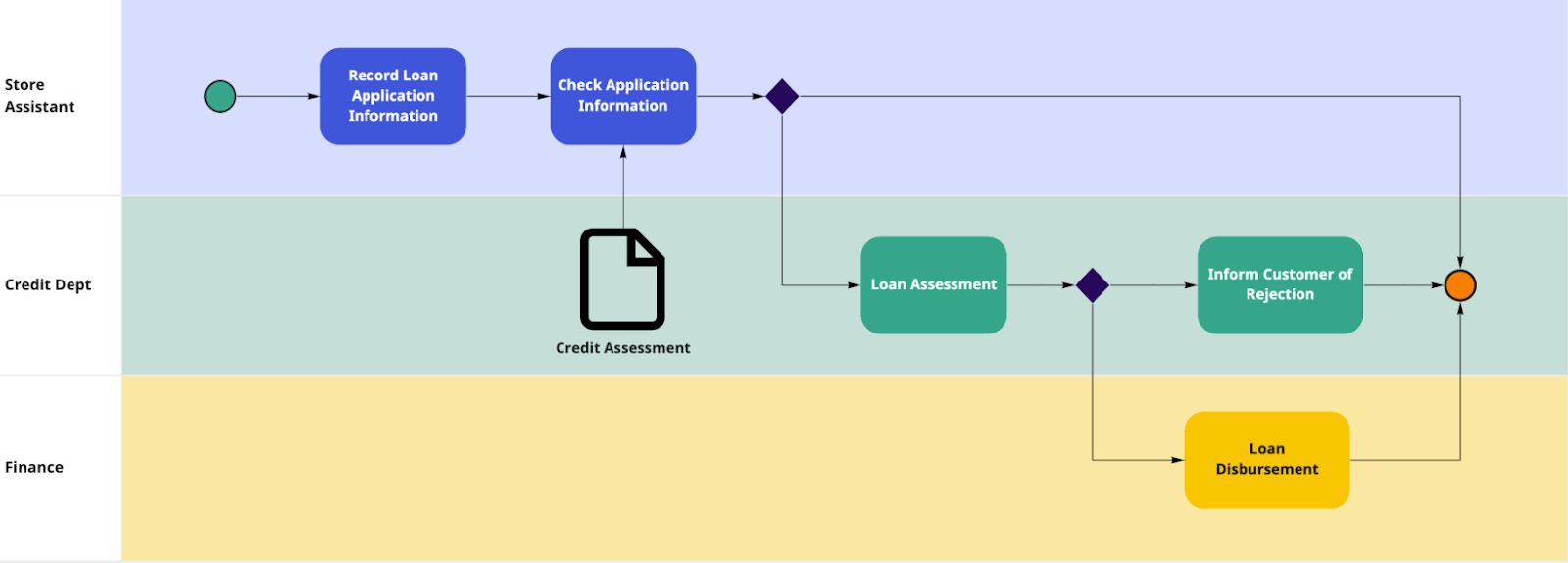
Here’s a more complete BPMN diagram that shows how the store assistant swimlane interacts with two other swimlanes — the credit department and finance.
The touchpoints between the processes are shown by incoming and outgoing arrows, representing the flow of information or activity.
Before you get started building BPMN diagrams, you may want to gather key stakeholders and complete a simple mind mapping exercise to pool the information you have about a particular process.
Mind mapping is a way to organize information that helps you visualize connections between ideas. This may help you identify the different participants in a process and where there are touchpoints with other processes that you need to consider.
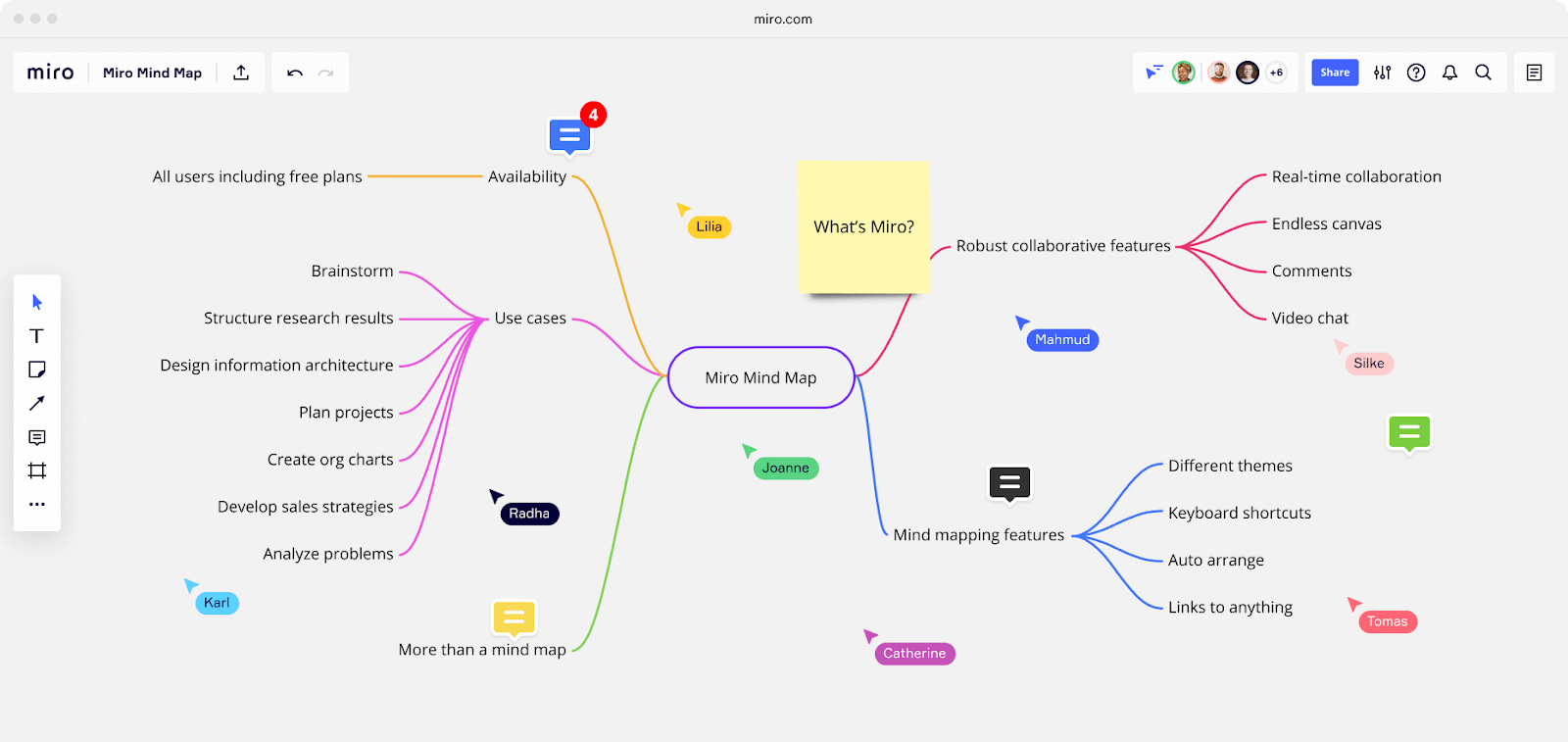
2. Flow elements
Flow elements are the geometric shapes you can see in the above business process model example. They include rectangles, circles, and diamonds. These flow elements represent specific events and activities that occur within the process.
Rectangular shapes are usually used to indicate activities within the process. Activities can be two main types — sub-processes and tasks.
As people use BPMN diagrams to describe a process in simple terms that a range of stakeholders can easily understand, it’s important they aren’t too complex. Using sub-processes helps to retain simplicity.
Sub-processes are a collection of tasks that need to be completed for the process to be successful but that you don’t want to focus on while mapping this particular process.
For example, a simple sub-process in our above example could be how the store assistant collects the customer’s loan application information.
Perhaps there are several options, including filling out a form on the website, completing a hard-copy application in store, or entering information electronically onto a tablet at Customer Services.
Those are all possible options but, to keep the process easy to visualize you don’t want to actually focus on that level of detail in this particular diagram.
A task is a basic building block of the process that cannot be broken down into a lower level of detail.
Circles usually represent events. Events are something that takes place that can impact the process, and they can be internal or external.
There are three types of events: Start Events, Intermediate Events, and End Events. Some diagrams specify the trigger that causes an event to happen.
Diamonds represent gateways. Gateways are responsible for controlling the outcome of the process by directing activity to either happen or not.
Let’s look at our example again to see how this works in practice. When the credit department completes the loan assessment, they have to decide how likely it is that the customer will be able to repay the loan.
If the risk is too high, the company rejects the application. This directs the store assistant to inform the customer that their application has been unsuccessful. This triggers a Stop Event.

3. Connecting objects
Connecting objects, unsurprisingly, connect different flow objects.
Sequence flows connect flow objects within the same pool, though they can be in different swimlanes. They are shown as a solid line with an arrowhead.
They show the order of the different activities, which should be completed in the direction the arrow is pointing.
If you want to connect flow objects between different pools, you’ll need to use a message flow. Message flows are shown as a dotted line with an arrowhead.
The final connecting object is associations. Associations show the relationships between flow objects and artifacts.
Artifacts allow business process modelers to augment the basic BPMN diagram with additional information. There are three types of artifacts.
- Annotations offer more detail about particular flow objects. For example, in our diagram above, the activity ‘Pay for Food’ could have a text annotation stating that this could be with cash or by debit or credit card.
- Groups allow modelers to organize activities, tasks, or sub-processes that are significant to the overall process into groups.
- Data objects represent data as an input or output of the process, or data that needs to be collected or stored.
Let’s look at that final one in a little more detail.
4. Data
It’s important to identify the flow of data throughout the process.
As mentioned above, there are several ways that data can interact with the process, and the Business Process Modeling Notation has specific symbols to annotate these interactions.
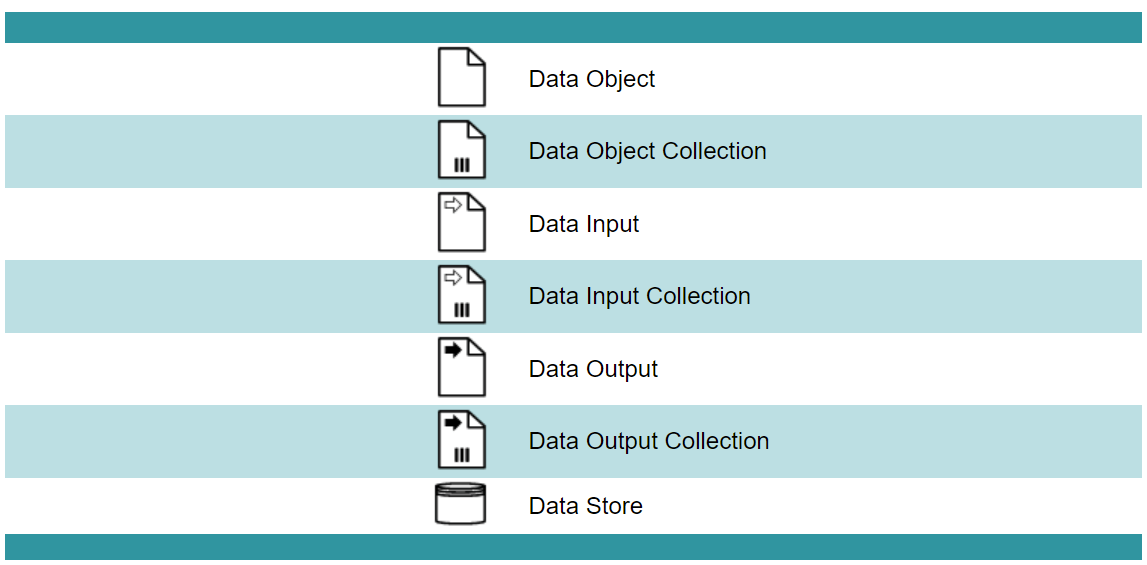
In our example above, data might include the application information being received by the credit assessment system and the loan assessment result being received by the Finance department.
If you’re trying to get your head around your data flow and how it interacts with your business processes, why not give our Data Flow Diagram a go?
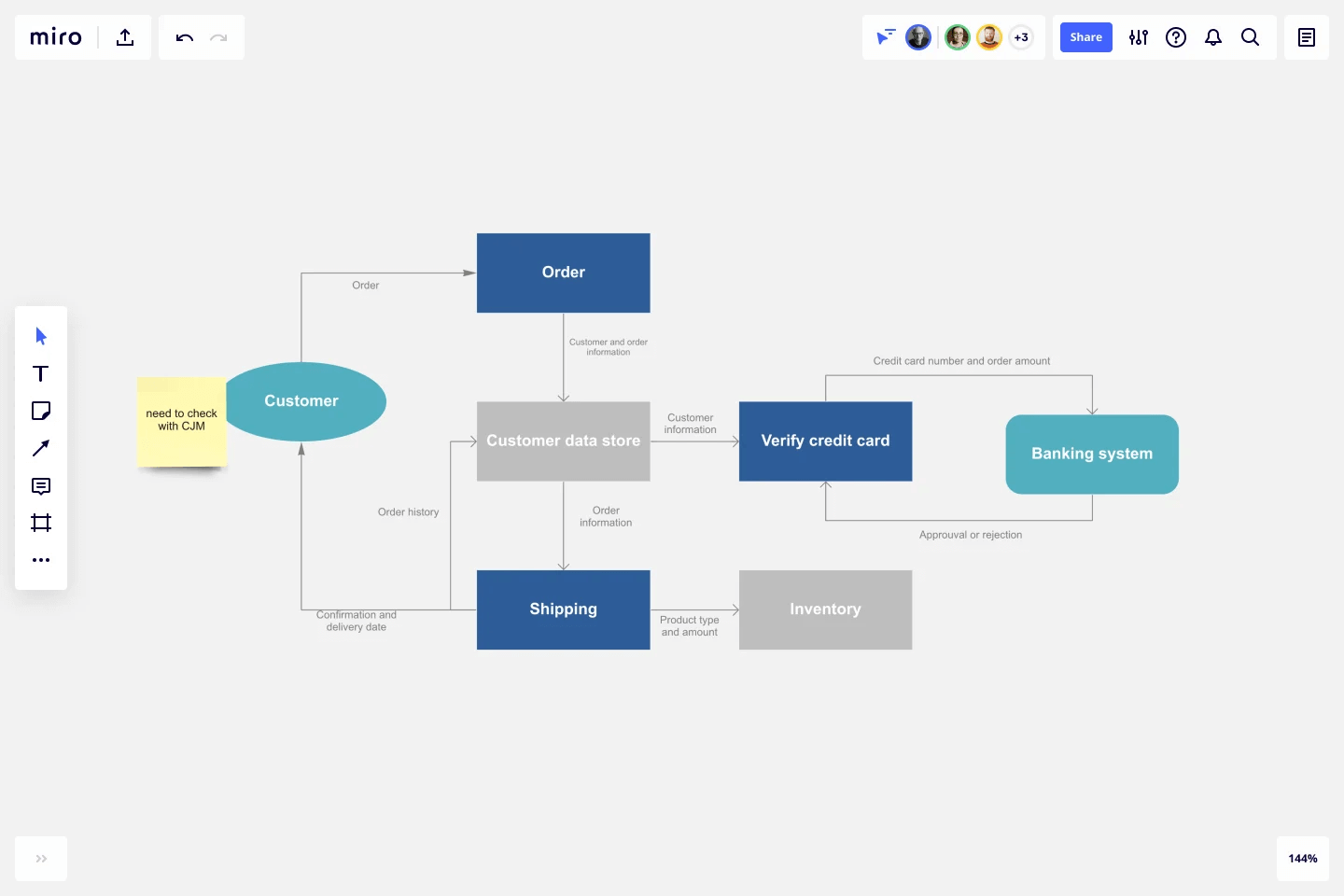
Like all our templates, it’s fully customizable, and it’s simple to add images and files to personalize your modeling and really get a sense of how data flows through your business.
Need help figuring it out? Simply give your team access and invite them to comment, ask questions, or make corrections.
How does BPMN compare to UML Activity Diagrams?
As mentioned above, there is a second common modeling notation language called UML.
It’s possible to use UML for modeling processes, but it’s much more widely used in modeling software systems. UML is described as object-focused compared to the more process-focused BPMN.
Typical users of UML would be people looking to model and build software systems like web applications. They can use the standardized notation to describe a design that can then be implemented in one of several programming languages.
BPMN is used in both business process modeling and business process mapping to design ‘As-is’ and ‘To-be’ systems. Typical users are business analysts, but it’s accessible to a range of businesspeople.
If you realize you’re more in Team UML than Team BPMN, don’t worry. We’ve got a template for UML diagrams too.
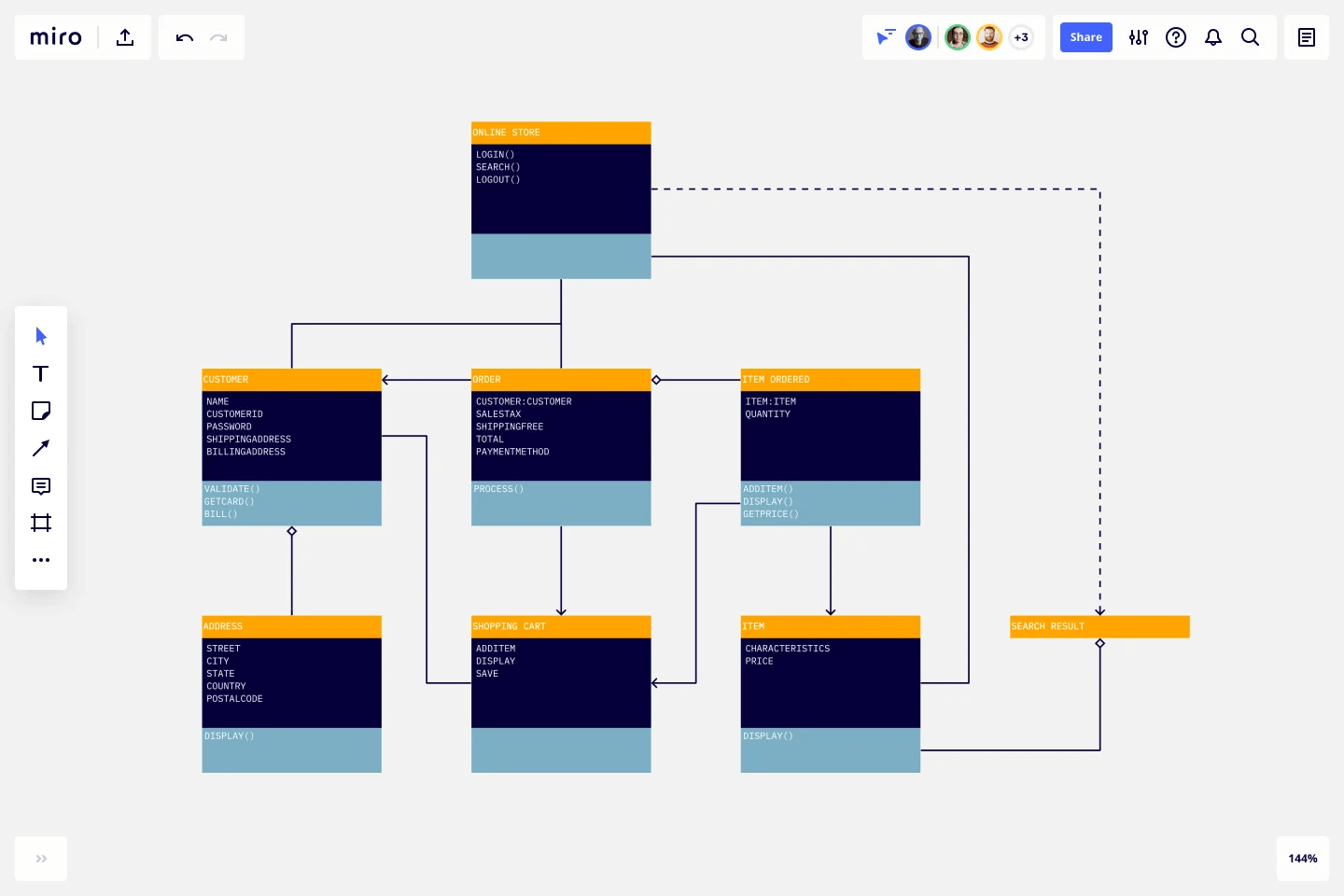
Whichever team you side with, we have you covered. Our interactive online whiteboard makes it simple to visualize your business processes.
With our Smart Diagramming feature, it’s quick and easy to create business process diagrams using advanced shape packs that align perfectly with the BPMN methodology.
Once your process is mapped out, it’s easy to get feedback from your team and other stakeholders. Simply give them direct access to your whiteboard so that they can go in and make changes, add files or images, or jot down annotations.
And, our all-in-one diagram maker means you don’t waste time switching between your diagramming and other collaboration tools. So your focus can stay where it needs to be — on creating the most efficient processes for your business.
After you finalize your diagram, it’s time to start making changes. Our project management tools can help you organize the work you need to complete, plus we have integrations with leading task management solutions like Jira and Asana.
BPMN drives efficiency in your business
As we said, businesses can be complicated. Designing and implementing new processes can be challenging, especially if they require collaboration between departments or functions.
Business process modeling and BPMN diagrams allow teams to visualize new processes before implementation to make sure they maximize efficiency.
Our online collaborative whiteboard helps stakeholders come together to design, discuss, and iterate complex processes.
Miro makes it easy to map end-to-end workflows, imagine new solutions, and make changes in real-time.





